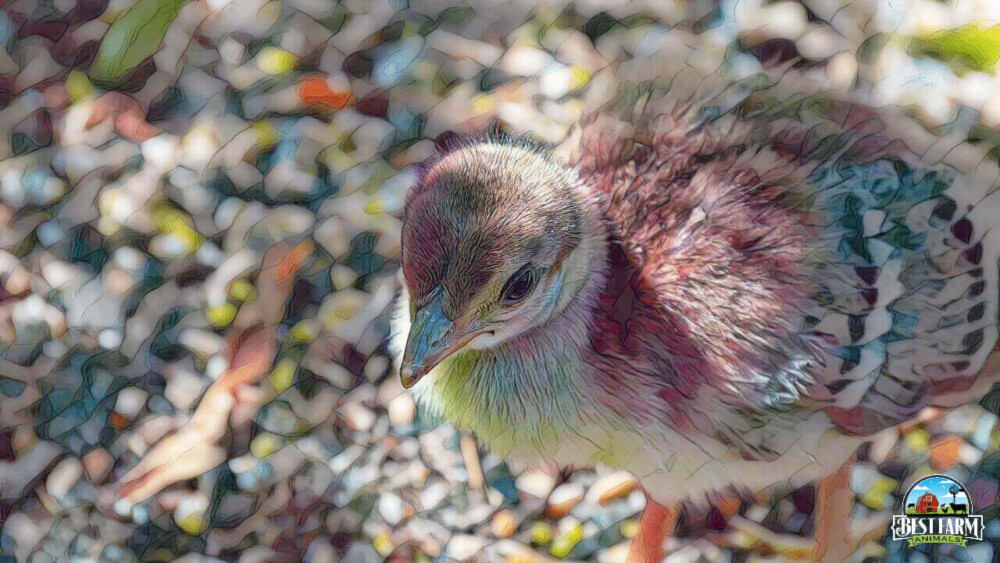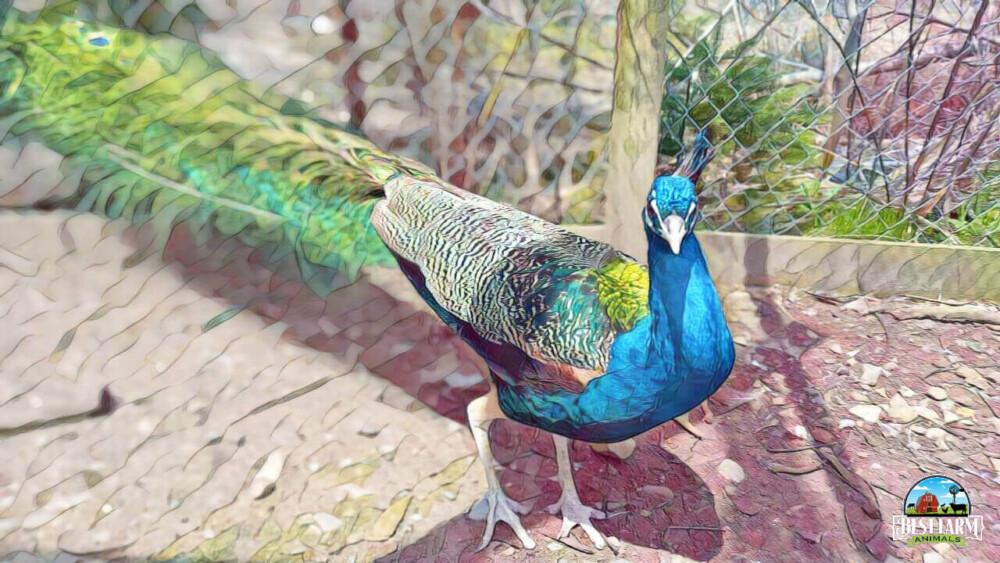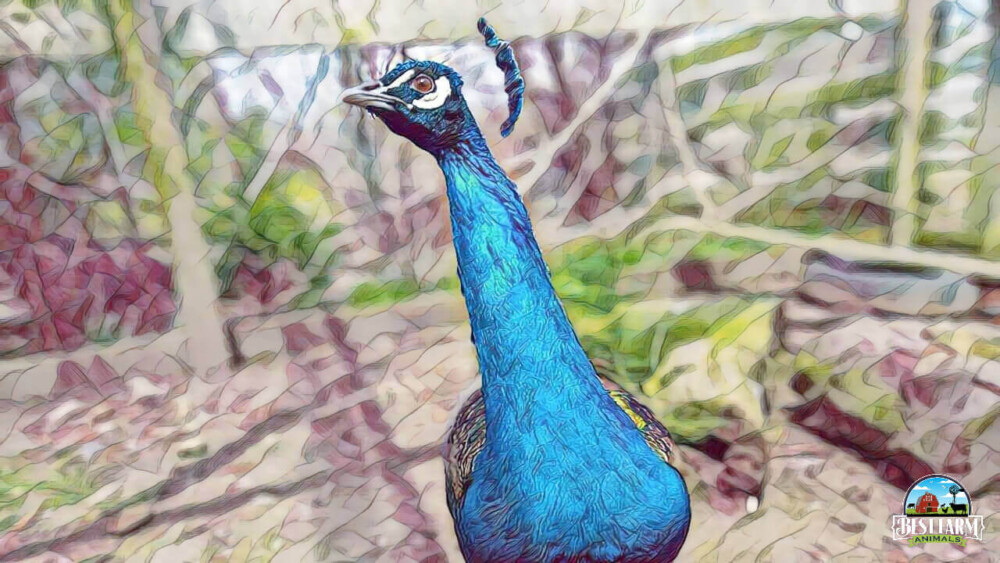Peafowl are gorgeous birds, but hatching out your own chicks and raising them into adults might be even more rewarding! Perhaps you want to become a breeder to make an extra profit, or maybe you simply enjoy hatching your own peachicks.
Either way, this article is for you.
Raising peafowl has its challenges for beginners but can be rewarding and profitable. Ideally, you should start with one peacock and one to two peahens. You’ll need an incubator to hatch out your peachicks, or you can let your broody peahens raise them naturally.
This is Part One of a two-part series on raising peafowl. Keep your eyes open for Part Two soon!
Getting Started With Peafowl
Buying your first peafowl is an exciting time! Ideally, you should start with one peacock and two peahens, but a pair will also be fine. You can either purchase peachicks, yearlings, or adults. Be aware that most peachicks are unsexed, meaning you won’t know how many peacocks to peahens you have.
Here are a few tips to help you:
Set a Budget
You can easily blow your budget on peafowl, so make sure you have a set limit ahead of time. Then you can choose what variation, quality, and other factors you can afford in your birds.
For example, you might only want to spend $100 per bird. You’ll probably look for standard farm-bred India Blue peafowl in that case. However, if you have a budget of $250-$300 per bird, you may be able to afford breeder-quality India Blue peafowl, leucistic peafowl, or pied peafowl.

Pick a Variation
Did you know that there are over two-hundred-fifty variations of India Blue peafowl? Before you begin your search for your birds, you should select a variation you like.
My favorite variation is the opal, but many others prefer the more colorful types. The leucistic (or white) variation is a popular favorite. If you’re just starting, you may prefer to keep standard India Blue peafowl.
I recommend choosing between one to three favorites. That way, you can fall back on one if you can’t find a breeder for that particular variation. Eventually, you can also build your stock up to include three variations, which opens up more diversity!
Settle On an Age
Peafowl are essentially fancy turkeys, right? Unfortunately, no. Peafowl takes a long time to mature sexually, unlike turkeys. It will be two years before a young peahen starts laying her first eggs, and most peacocks aren’t fertile until their third year!
Peachicks are less expensive than yearlings and adults, but they are usually unsexed, tend to be extremely delicate, and require a longer investment. You’ll have more time to gain practical experience if you start with peachicks. Hand-raised peachicks are also more likely to bond with their handlers.
Yearlings are more expensive and hardier and can be sexed based on appearance and behavior. If you’re inexperienced with peafowl, I recommend starting with peachicks or young peafowl. This way, you can gain plenty of hands-on experience with them before it comes time to breed.
Locate Breeders
Now for the fun part. You can check out your country’s peafowl breeder’s association for a specific list of breeders in your area. Try to find a reputable breeder with exceptional ratings.
Avoid Inbreeding
You may need to buy your peafowl from separate breeders to avoid inbreeding. This is an issue particularly common in backyard farms. Good breeders, on the other hand, have meticulous records and organize their stock in such a way as to avoid unintentional breeding.
If you’re purchasing both a female and a male from a breeder, make sure you ask to see the records! It’s fine to have two peahens, sisters or a mother-daughter duo, as long as your peacock is unrelated. Even so, aim for genetic diversity!
As a general rule, try not to buy more than one bird from a breeder that free-ranges their peafowl. It’s impossible to differentiate the genetics of eggs from free-range peafowl.

Look for Healthy Birds
The peafowl you choose should have vibrant colors, clear eyes, straight toes, and clean feces. Moreover, they should be alert, active, and display normal, healthy behavior. If you notice any red flags, don’t buy!
Build a Coop
Peafowl require an insulated shelter to protect them from the elements. Coops should be at least 10ft by 10ft to accommodate one or two peafowls. Include plenty of roosting options for them – peafowl love being up high!
Even if you want to eventually free-range your peafowl, they still need a coop to sleep in. You should also provide them with a connected enclosure. Never free-range peafowl that you just brought home! Allow at least a few months before you begin free-ranging your birds. They won’t associate your property as their territory if you don’t wait.
Breeders have another reason for avoiding free-ranging their peafowl. Peahens tend to find a private, remote niche to lay their eggs in, making them vulnerable to predators. It’s also far more difficult to locate the nest, particularly if you live near a forest.
| Tip: Use secure hardware cloth wire to fence in the enclosure for your peafowl. This has more endurance and offers more protection than flimsy chicken wire. |
Breeding Season for Peafowl
Peafowl are slow to mature. Come a peacock’s third year, he’s ready to breed reliably. Some peacocks may be fertile as young as two years of age, but wait until he’s three for the best results. Peahens usually reach sexual maturity at two years of age. Expect a younger peahen’s first eggs to be infertile.
The breeding season for peafowl runs from February to August. However, February consists only of their mating rituals, such as courting. This is when peacocks start developing and fanning out their trains – and when peahens fan out their short tails! Peafowl only mate later in the spring, usually in May or June.
At maximum, one peafowl harem should have five peahens to every peacock. Peacocks don’t consistently breed with more than five peahens, so you’d have an uneven distribution of fertile eggs.
Peacocks are extremely territorial and often fight with other peacocks to the death, so don’t keep more than one peacock in one enclosure. If you do, increase the space and number of hens. So there should be eight to ten peahens if you have two peacocks.
You’ll start to find large, creamy-colored eggs between June and August. Most peahens lay between one and three clutches of eggs per year, and each clutch consists of five to twelve eggs. Collect your peahen’s eggs immediately unless you’re letting her set them.
How many eggs do peahens lay? The more mature the peahen, the more eggs she’ll lay. So a five-year-old hen may lay three clutches with an average of nine eggs per clutch in a year, but young hens may only lay one clutch of four eggs in the entire breeding season.
Sometimes peahens lay daily until their clutch is complete, but it’s far more common for them to lay irregularly. Azule lays every other day, but Azora might only lay an egg every few days.
Peacocks drop their lovely train feathers in late July through to early September, marking the conclusion of their breeding season. You can sell the feathers or use them in crafts and decor!

Should You Incubate or Let Peahens Set Naturally?
You have a few options when it comes time to collect and incubate your peahen eggs. Most people prefer artificial incubation, but you can also allow your peahens to set their eggs – or find a chicken hen!
No matter what you choose, mark the date that you set the eggs with a pencil! It’s also helpful to check off the passing weeks on a calendar.
Peahens Hatch Their Own Young
Last year, Azule was broody for the first time, so we allowed her to set her own clutch. Unfortunately, only one peacock hatched and survived.
Natural incubation has its own set of pros and cons. Peahens are similar to guinea hens; they tend to abandon the nest. Unlike chickens, young peahens are also rarely broody. On the other hand, peahens are maternal with the peachicks and you won’t have as much work to do.
You must ensure that a broody peahen is safe from her flock of peafowl and predators. Too many free-ranged peahens have been lost to foxes as they set on their eggs! She should ideally be confined separately in a dog kennel with bedding.
Your peahen needs constant access to water. Try to find a shallow waterer that you can continue using when the peachicks hatch – you don’t want them to drown!
Be careful not to disrupt the peahen if you choose to candle the eggs during natural incubation.
Setting Peahen Eggs In an Incubator
Most people prefer to set their eggs in an artificial incubator. This method requires the most effort and commitment from you, but you’ll also be able to monitor for any changes more easily. If you’re breeding peafowl for profit, I recommend using an incubator.
Set the temperature to 99.5 degrees F, and maintain the humidity at around 60%. After the first 26 days of turning the eggs, carefully move them to a hatcher. Once all the chicks have hatched, they can be relocated to the brooder.
Broody Chickens Can Raise Peachicks
You can slip some peahen eggs under a broody hen if you have chickens. This is the most reliable method we’ve found. It’s also less expensive than buying peacock eggs.
Silkies and australorps are particularly exceptional mothers. They’ll hatch out and raise anything!
All you need to do is collect your peahen eggs until her clutch is complete and set up a broody hen in a brooder with the eggs. I like to build a nest and toss in some rose petals to make it more appealing.
Your hen needs bedding of some kind, preferably shavings, sawdust, or straw. She also needs a waterer and a food dish. In twenty-eight days, the eggs will hatch and the hen will happily care for the peachicks as her own.
Candling the Eggs
Candling helps you determine eggs that haven’t been fertilized and embryos that stop developing. Infertile eggs become obvious within ten to fourteen days of being incubated.
You can candle your peahen eggs around fourteen days after incubation and again on the twenty-sixth day. Ensuring the eggs remain warm while you candle them is important.
You can use a candler such as this one (on Amazon) or alternatively a flashlight and some cardboard. Always remember to candle eggs in a dark room. If the egg appears translucent, it’s infertile. Toss these eggs away to avoid contaminating the rest of the clutch. Signs of development and fertilization include a dark spot and blood veins.

When Hatching Day Arrives
Peahen eggs take 28 days to hatch. Sometimes there are early or late peachicks. As a rule, we wait five days after the four weeks (33 days total) in case there’s a late bloomer. Peachicks have a low hatch and survival rates, so expect that not all eggs in a clutch will hatch. Last year, only two out of nine eggs hatched, in contrast to four out of six in normal years.
You’ll hear peeping from within the egg before the chick pecks its shell open. Peachicks can take up to twenty-four hours to hatch! It’s an exhausting process for the chicks, so they rest in spurts to regain enough energy to continue pecking at the shell.
Don’t be immediately alarmed if your peachick stops pecking. Usually, peachicks can hatch without assistance, but occasionally you may need to help the chick along. Only peel the eggshell back if the peachick has pecked a ring around the egg. If you don’t wait, you might risk your peachick bleeding excessively from the umbilical cord.
Cover the bottom of the cage with a substrate the chicks can’t slip on, such as straw or shavings. Don’t use newspaper!
Raising Peachicks
Peachicks tend to be delicate and finicky, so extreme care should be taken to help maximize your peachick’s chance of survival. It’s important to keep your peachicks dry and warm. They are far more susceptible to the elements than baby chickens! It’s also useful to learn about orthopedics to prepare you for any issues that may arise.
Housing Your Peachicks
Peachicks should be housed in a non-drafty brooder until they are six to eight weeks old. Keep the brooder’s temperature at 95 degrees F for the first week after hatching. Decrease this by increments of five degrees every week to help their systems gradually acclimate.
They can be moved to a raised pen at six to eight weeks of age. Most experts recommend keeping peachicks away from areas where an older bird has inhabited to limit the spread of disease and parasites.
As lovely as it is to see peachicks roaming freely with their mother, don’t free-range chicks! Peachicks are extremely vulnerable to attacks from neighborhood cats, dogs, foxes, weasels, raccoons, hawks, and other predators. They also tend to get lost easily.
That said, peachicks are quite active and for optimum development should be provided with plenty of space.
Dietary Requirements for Peachicks
Peachicks require a high-protein diet that turkey or game bird starter feed provides (on Amazon). You can switch them to turkey grower at four months of age. You can also supplement them with mealworms, cottage cheese, and cooked eggs. They should always have access to fresh, clean water.
Sexing Peachicks
Accurately determining the sex of peachicks is difficult until they reach 8-10 weeks of age. Males slowly develop more intense barring on their back feathers, and their breast feathers will turn rusty. Any amount of blue on your peachick indicates he’s a male.
Female peachicks gradually lose barring on their backs and develop green breast feathers laced with a creamy color. Their wings also turn more charcoal grey. Eventually, they gain their beautiful emerald green plumage.
Bonding With Your Peachicks
Peafowl have independent natures but can form strong bonds with certain humans. You can help facilitate this by handling your peachicks every day so they become more comfortable with human touch.
Hold them firmly but gently. You don’t want to hurt them by accident! Remember to hold their wings to their bodies to prevent them from flying or jumping away and injuring themselves.

Breeding Peafowl for Profit
Peafowl can be quite profitable to breed. You can sell hatching eggs, young peachicks, yearlings, or even offer a few different options to your customers.
I recommend starting a social media page as well as a website. Display good quality pictures of your breeders and maintain a regular presence. Interact with your audience!
Determine pricing before you start breeding your peafowl. If you offer multiple variations or ages, try creating a simple, easy-to-follow price guide.
You can sell hatching eggs for between $35-$60, peachicks between $20-$60, and yearlings for $50-$400. Specific prices depend on the quality of your birds, local demand and competition, and variations.
All responsible breeders should be prepared to answer your customers’ questions about peafowl. This encourages more awareness in the community of peafowl keepers! In addition, you must keep meticulous breeding records, work on building a great reputation, and familiarize yourself with peafowl genetics and variations.
Frequently Asked Questions
What is a group of peafowl called? A group of peafowl is called a muster or a bevy.
Are peafowl monogamous? Peafowl are polygamous, not monogamous. Each male breeds with multiple peahens, but harems are relatively small, with a ratio of five hens to every peacock.
Can I feed my peafowl chicken ration? Peafowl can eat chicken feed, but it isn’t formulated to care for their unique dietary requirements. You’ll need to supplement their feed with extra protein from meat, dog or cat kibble, worms, and other sources.
Can I keep peafowl with other birds? You shouldn’t keep peafowl in the same enclosure as other birds such as chickens, ducks, turkeys, pheasants, geese, and guineafowl. This limits dangerous diseases transmitted between species, like blackhead disease, and also protects your birds from fighting.
What bedding is best for peacocks? You should cover the floor of your peafowl coop with pine shavings. Cedar shavings are toxic to all animals, so never use this!
Do peacocks mate for life? Peafowl don’t mate for life. India Blue peacocks mate in harems of 4-5 peahens each breeding season. This makes peafowl a polygamous rather than monogamous species.
How many eggs a day do peafowl lay? Peahens lay a maximum of one egg daily until her clutch is complete. However, most peahens lay an egg every other day.
How many eggs are in a peahen’s clutch? Peahens lay between 4-12 eggs per clutch, and they lay one to three clutches of eggs per year.
Do peahens lay eggs without a peacock present? Peahens don’t require peacocks to fertilize their eggs in order to lay. This means that you’ll receive unfertilized eggs if you prefer not to keep a peacock with your hens.
Conclusion
Raising peafowl is an incredible and worthwhile experience. They are stunning and intelligent birds you’ll never cease to find fascinating, and you can even form a bond with them! Remember to be picky about where you choose your breeders from, build an online presence, and take extreme care with your peachicks.
Resources
US Breeders Directory of Peafowl

